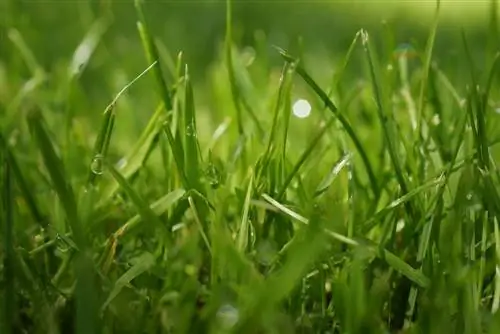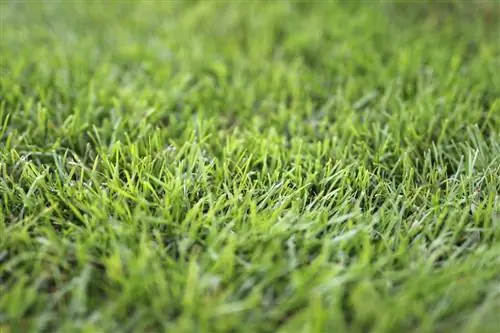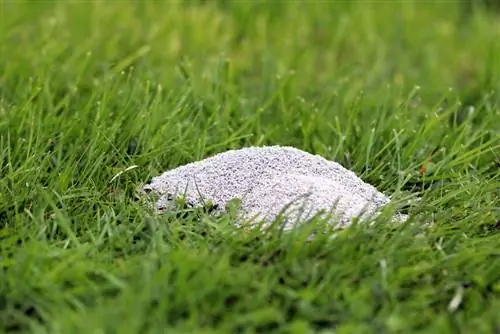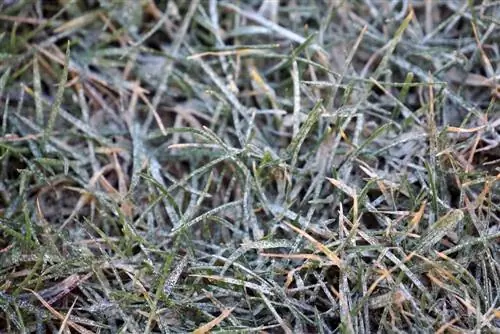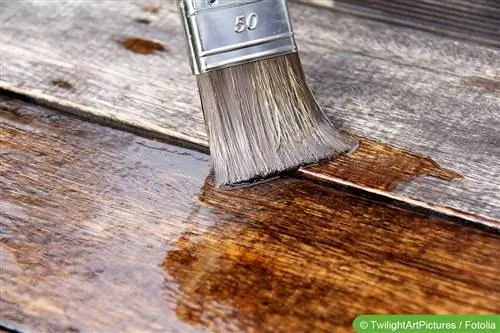- Author admin [email protected].
- Public 2023-12-17 03:39.
- Last modified 2025-01-24 12:45.
Every lawn suffers in winter. Cold and snow demand a lot from the greenery. This is especially true if it has been extremely cold for weeks and a thick blanket of snow has covered the lawn. In order to shine in new splendor, the lawn needs a lot of nutrition in spring, i.e. lawn fertilizer. However, fertilizer alone is not enough.
Preparation
Before the lawn can be fertilized for the first time in spring, it must be prepared. What exactly this preparation looks like depends largely on the specific condition of the green. For example, if there are still leaves from autumn on the area or there are dead branches lying around, both must first be removed. Other foreign objects such as leftovers from New Year's Eve fireworks should also be carefully collected and disposed of. Once this has happened, it is important to take a close look at the lawn itself. The main questions are:
- Does the lawn need to be mowed yet?
- Is it mossy or matted?
- Are individual parts of the lawn or plants dead?
Depending on the situation, different measures are recommended:
- for leaves: Rake the lawn thoroughly
- blades of grass that are too long: be sure to mow
- mossed or matted: scarify first
- dead elements: remove dead grass and reseed bare spots
All of this work serves to optimally prepare the lawn for the first fertilizer application. They should be tackled as soon as the snow is completely gone and the ground is no longer expected to freeze. Of course, this can vary greatly from year to year and from region. If individual blades of grass are still frozen, the measures must not be attempted under any circumstances.
Note:
The lawn may only be scarified when the ground temperature is at least twelve degrees Celsius. Colder soil can cause significant damage to the root system.
Time
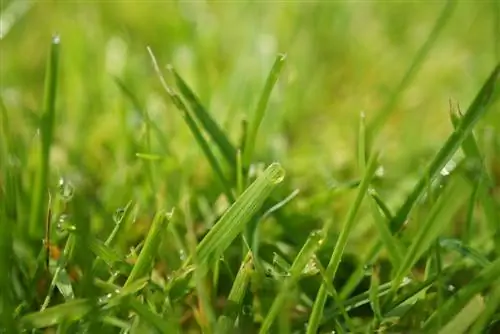
The question about the right time to apply the first fertilizer in spring is often answered as March or April. In principle this is true, but it always depends on the specific weather conditions. If there is still snow in April, fertilizing obviously makes no sense. In addition, under no circumstances should the ground still be frozen. In general, it can be said: the winter conditions should definitely be over and warming spring temperatures should be approaching. This is usually the case in May at the latest in most regions.
Note:
You should definitely not fertilize in January and February, even if there is no more snow and there is no more frost on the ground. The risk of another onset of winter is simply too great at this point.
Lawn fertilizer
With the start of the new season, the lawn is generally very hungry. It needs a lot of nutrients to compensate for the stresses of winter. In addition, he needs to recharge his batteries for the new growth phase. The spring fertilizer should enable him to do just that. Fertilization at this time plays a crucial role in how the lawn develops over the course of the year. The fertilizer should definitely contain the following components:
- Nitrogen
- Potassium oxide
- Phosphate
- Calcium
- Magnesium
- Boron
- Zinc
- Manganese
- Copper
- Iron
The proportion of nitrogen should be around 25 to 30 percent. That of potassium oxide is around 15 percent. Substances such as boron, zinc and manganese are trace elements that are only needed in minimal proportions. Regardless of the content, it is advisable to ensure that the fertilizer you choose has a long-term effect and does not release all of its nutrients immediately. Whether such a long-term effect exists is noted on the packaging of the relevant products.
Fertilize
Once you have found the right fertilizer, you can then get down to fertilizing. The fertilizer is usually in powder or granular form and is delivered in bags. How much of it you need for a specific lawn area can usually be seen from the information on the packaging. The manufacturer's information is usually very reliable, but they sometimes differ significantly from product to product. The lawn fertilizer must be distributed as evenly as possible over the entire area. If you apply too much fertilizer in one place and too little in another, different growth may occur - and you will see this later in the lawn. You can use a small shovel or your hands to spread the fertilizer.
Tip:
Since a lawn needs to be fertilized not only in spring, but a total of four times a year, it is worth purchasing a fertilizer spreader. This is a cart that can be used to dose the fertilizer doses in a targeted manner.
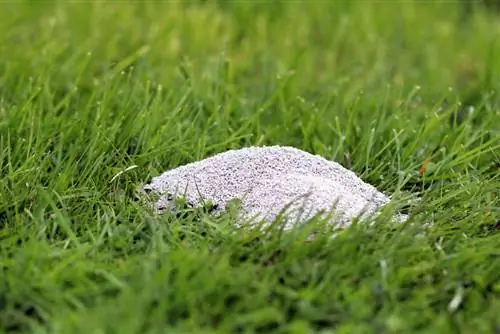
After the first fertilizer application in spring, the lawn definitely needs moisture. The water means that the fertilizer dissolves more easily and is therefore available to the plants more quickly. Either you fertilize when it is likely that it will rain very soon or you water the lawn after fertilizing. Relatively gentle irrigation is often sufficient.
Additional measure
It is absolutely recommended to determine the pH value of the soil before or parallel to the first fertilization of the lawn. If the soil is too acidic, any type of fertilizer application is usually relatively ineffective. Soil is considered too acidic if the pH value is below 5.5. If this is the case, lawn lime should be spread over large areas immediately. A few days after applying the lime, the pH value must be determined again and, if necessary, relimed.

